Ijraset Journal For Research in Applied Science and Engineering Technology
- Home / Ijraset
- On This Page
- Abstract
- Introduction
- Conclusion
- References
- Copyright
Analysing Cultivation Trend of Major Crops in Baghpat District of Uttar Pradesh (A Comprehensive Economic Study)
Authors: Dushyant Kumar, Professor Arun Solanki
DOI Link: https://doi.org/10.22214/ijraset.2024.63817
Certificate: View Certificate
Abstract
This study focuses on the cultivation patterns of four major crops—sugarcane, wheat, paddy, and oilseeds—in Baghpat District, analyzing both economic and environmental factors. Sugarcane, as the primary crop, is examined alongside wheat, paddy, and oilseeds to provide a comprehensive view of the agricultural landscape. The study examines fluctuations in farming areas and production yields of these crops in India, with Uttar Pradesh as a significant contributor. Factors influencing regional agricultural practices include land tenure, ownership, holding size, and soil type. Baghpat District, part of western Uttar Pradesh, showcases sugarcane as the dominant crop, particularly in Baraut, Chhaprauli, and Binauli blocks. The research adopts a descriptive approach, utilizing purposive sampling to select relevant data from these blocks. Data from 120 farmers across six villages were analyzed, focusing on those dedicating over 80% of their land to sugarcane, while also considering wheat, paddy, and oilseed cultivation. The study period spans from 2019 to 2022, aiming to capture trends and challenges in the production of all four crops. The findings emphasize the need for sustainable practices to maintain productivity and address environmental concerns in the region, while also highlighting the relation between sugarcane cultivation and the production of wheat, paddy, and oilseeds.
Introduction
I. INTRODUCTION
Sugarcane, scientifically known as Saccharum officinarum L., is a plant from the gramineae family that is assumed to have originated in the tropical regions of South and Southeast Asia. Sugarcane is a renewable and naturally occurring agricultural resource that produces ethanol, fiber, and fertilizer, among other environmentally beneficial byproducts. Sugarcane juice can be processed to produce white sugar, brown sugar (Khandhasari), jaggery (Gur), and ethanol. Sugarcane juice contains 111.13 kilocalories (26.56 kilojoules) of energy per serving (28.35 grams), 27.51 grams of carbohydrates, 0.27 grams of protein, 11.23 milligrams of calcium, 0.37 milligrams of iron, 41.96 milligrams of potassium, and 1.01 milligrams of sodium (Nutrient Information from ESHA Research). According to data on sugarcane farming in India, the highest area was 50.66 lakh hectares in 2014-2015, while the lowest was 41.7 lakh hectares in 2009-2010. Sugarcane output peaked in 2018-19 at 4003.69 million tonnes, while it fell to 2923 million tonnes in 2009-10. The highest output was produced in 2018-19, at 75.5 tonnes/ha, while the lowest yield was in 2012-13, at 68.25 tonnes/ha. (Department of Food and Public Distribution (Sugar Production) and Agricultural Statistics (Sugar Cane Production and Area), 3rd Advance Estimate Agricultural Statistics Division, June 2019). The perception and evaluation of the environment influences the development of distinct crops in a given region. Cultivation practices vary less in places of the earth with less physical diversity. Farmers in drought-stricken Rajasthan (India) produce bajra (bulrush millet), while rice is the primary crop in Assam's Brahmaputra basin. Cotton is grown in the regur (black earth) soil of Maharashtra and Gujarat, whereas wheat, rice, and sugarcane thrive in the loamy soils of western Uttar Pradesh, Haryana, and Punjab. Land tenancy, land ownership, holding size, and field size all constrain a region's agricultural practices. According to data on the size, production, and productivity of sugarcane farming in Uttar Pradesh, the maximum area under sugarcane cultivation in Uttar Pradesh was 21.80 lakh hectares in 2020-21, while the smallest area was 19.77 lakh hectares in 2009-10. This information was acquired from 2009-2010 until 2020-21. Sugarcane production hit a record high of 1776.72 million tonnes in 2020-21, compared to a low of 1,111.4 million tonnes in 2009-10. The lowest yield was achieved in 2010-11 at 56.73 tonnes/ha, while the highest yield was recorded in 2020-21 at 81.50 tonnes/ha.
Uttar Pradesh's main sugarcane producing districts include Bareilly, Muzaffarnagar, Bulandshahar, Meerut, Baghpat, and Saharanpur.
The western part of Uttar Pradesh has 38 agricultural systems (Agricultural Economics Research Review, 2008), with sugarcane-livestock-cereals-fodder being the most common. Sugarcane (58%) is the region's primary source of income for cultivators. Sugarcane growing is prevalent in Baghpat district. According to the district cropping pattern, sugarcane is the predominant crop in Baghpat. Sugarcane occupied 43.7 percent of the total planted acreage in the Baghpat district in 2018-19, while it accounted for 31.06 percent of the crop area that year. Baghpat's crop pattern reveals that sugarcane acreage has been relatively stable over time. Despite the fact that they owe sugar mills several crores of rupees and routinely complain about low prices, farmers in the district like cultivating sugarcane. Sugarcane is a major industry and source of employment for farmers in the study region. The only crop produced by farmers that provides considerable income and employment to growers.
According to Prasad's (1987) study on the area, output, and productivity of pulses in Bihar from 1960-61 to 1989-90, gram and lentil production were consistently greater in Zone III, whereas arhar production was higher in Zone I. Growth rate study revealed that the compound growth rates of area and pulse production have, for the most part, converged across the state, with the exception of gram production in Zone VI, arhar production in Zone V, and lentil production in Zone 1. Lentil showed positive area growth only in Zones II and IV.
Verburg and Veldkamp, 2001 A single research methodology cannot provide a comprehensive examination of land-use change. Instead, a series of techniques are required to connect and integrate disciplinary components on a variety of geographical and temporal levels. This work introduces a modeling methodology for analyzing the spatial and temporal dynamics of land use at the regional level. The methodology investigates the dynamic functioning of land-use systems, which is critical for closing the gap between studies that highlight problems related with land-use change and research that try to understand and manipulate land-use change processes. Larson et al. (2004) investigate the factors that cause volatility in area, yield, and production for main crops in India from 1950-1951 to 2001-2002. This time is divided into two parts: pre-Green Revolution and post-Green Revolution, with each evaluated separately as well as together. A similar study is conducted for rice yields in the top five producing states. The data reveal that crop production growth has been predominantly driven by yield increases, particularly with the advent of Green Revolution technologies. According to Sharma (2005), crop diversification toward high-value cash crops such as fruits and off-season vegetables that are compatible with the region's comparative advantage is proposed as a potential approach to stabilize, raise from income, and increase land productivity. Sugarcane growers have been struggling financially for several years. Joshi et al. (2006) investigate the drivers of crop income development in Indian agriculture throughout the 1980s and 1990s. Using a method established by Minot (2003), the research divides crop income growth into four components: yield increases, area expansion, price increases, and diversification from low-value crops to high-value crops. The findings confirm that, at the national level, technology (greater yield) was the primary source of crop revenue growth in the 1980s, whereas rising prices and diversification emerged as the key drivers of agricultural growth in the 1990s. Birthal et al. (2007) discovered that agricultural patterns aligned with simple comparative advantage-based production decisions. The likelihood of farmers in India participating in fruit and vegetable agriculture, as well as allocating land to horticulture, decreased with land holding size. A small or medium landowner does not appear to devote a larger portion of their property to fruits and vegetables. However, the share assigned to vegetables increased dramatically with family size. Mishra and Shukla (2007) in their paper, ?Changes in cropping pattern in Madhya Pradesh, analyzed the changes in land use and associated cropping pattern during 1956 and 2001. Significant changes in the land use and cropping pattern has been recorded in Madhya Pradesh. The proportion of barren and uncultivated land has decreased significantly. The proportion of gross cropped area has changed from food grains to nonfood grains. These changes have prime importance because a little change in this sector may change the socio- economic scenario in a region.
II. PROBLEM STATEMENT
The problem statement for this study revolves around understanding the factors influencing sugarcane, wheat, paddy and oilseed cultivation in Baghpat District, Uttar Pradesh. Despite being a major source of income and employment, sugarcane farmers in the region face numerous challenges, including fluctuating yields, financial instability, and environmental concerns. The district has a significant area dedicated to sugarcane cultivation, yet the productivity and economic returns for farmers remain inconsistent. Issues such as land tenancy, ownership, holding size, and soil quality further complicate the agricultural landscape. Additionally, the financial struggles of farmers, including debts owed to sugar mills and low market prices for sugarcane, exacerbate their difficulties. This study aims to identify and analyze the economic and environmental factors that impact sugarcane cultivation, with a specific focus on three blocks—Baraut, Chhaprauli, and Binauli—and six villages within these blocks. By examining the cultivation practices and productivity levels over the agricultural years 2019-2022, the research seeks to provide insights into improving the sustainability and profitability of sugarcane farming in Baghpat District.
III. RESEARCH METHODOLOGY
The study is a descriptive research project focused on understanding the various factors influencing sugarcane cultivation in Baghpat District. The methodology involves both data collection methods and analytical techniques to achieve this aim. The sampling design for the study is based on a purposive selection process to ensure the most relevant and representative data. The research is conducted in Uttar Pradesh, with a specific focus on Baghpat District, selected for its significant sugarcane cultivation and the availability of necessary resources for the crop. Within Baghpat District, three blocks—Baraut, Chhaprauli, and Binauli—were chosen randomly from a total of six blocks. The selection was influenced by the number of sugarcane cultivators and the productivity levels of sugarcane cultivation in these blocks. Further narrowing down the focus, six villages were randomly selected from the chosen blocks. These villages—Bijrol, Malakpur, Basauli, Ramala, Pusar, and Jiwana—were chosen due to their high percentage of land dedicated to sugarcane cultivation . Finally, from each village, 20 farmers who dedicate more than 80% of their land to sugarcane were selected, resulting in a total of 120 respondents for the study. The data was collected for the agricultural years 2019-2022. The method of inquiry and the specific tools used for data collection are not detailed in the provided text but would typically include surveys, interviews, and field observations. While the specific analytical techniques are not detailed, such studies generally use statistical analysis to interpret the data collected, possibly including regression analysis, trend analysis, and comparative studies between different respondent groups.
IV. RESULTS AND DISCUSSION
The size of a holding is thought to be positively correlated with the volume of food grains produced. Farmers with bigger holding sizes are economically better off, and they can easily adopt improved farming practices. On the other side, farmers with smaller farm units are encouraged to produce as much as possible in order to sell both ends and better their economic situation, as illustrated in Table 1. This table shows that the overall average size of farms was 1.26 ha, ranging from 0.55 ha on marginal farms to 0.83 ha on small farms and 4.27 ha on medium farms, with a net cultivated area of 121.46 ha on sample farms.
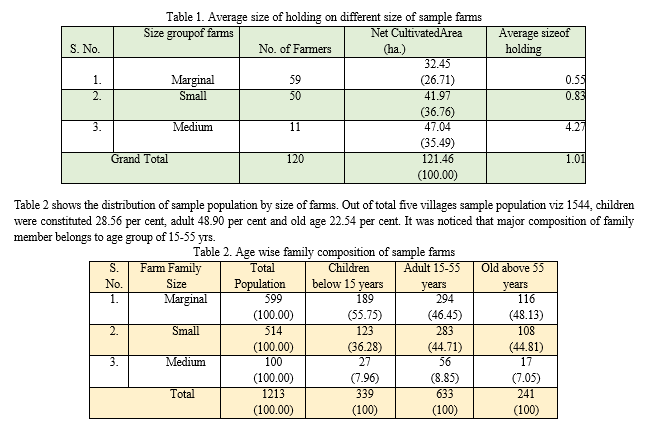
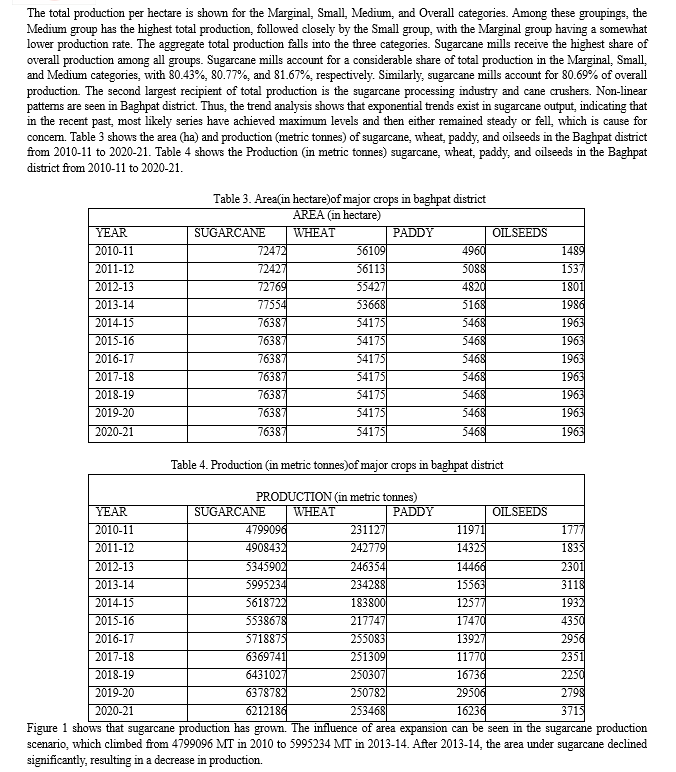

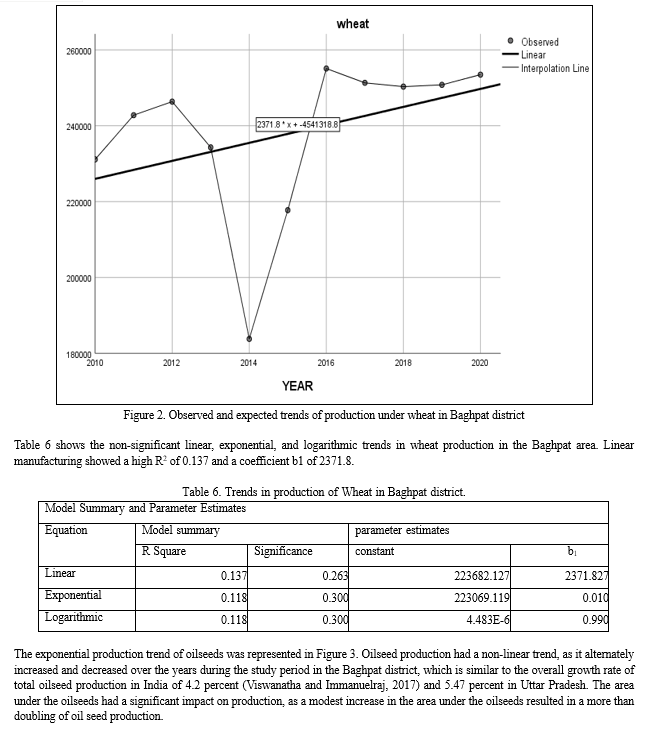
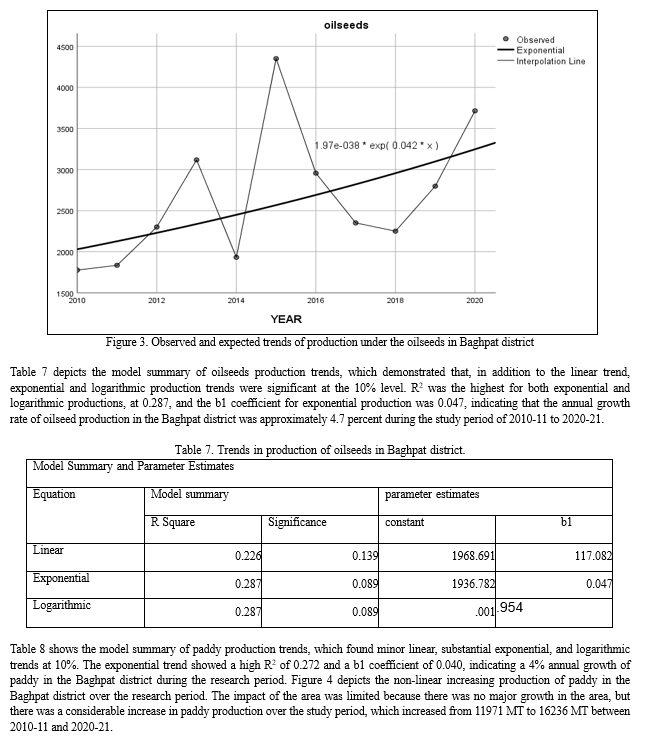
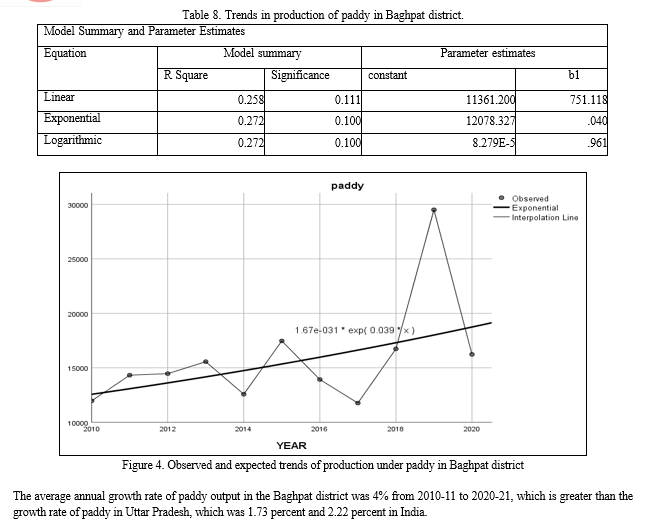
Conclusion
The conclusion of this study underscores the complex agricultural landscape of Baghpat District, Uttar Pradesh, with a focus on four key crops: sugarcane, wheat, paddy, and oilseeds. The analysis reveals that while sugarcane remains the predominant crop and primary source of income for farmers, the other crops play significant roles in the district\'s agricultural economy and food security. Sugarcane cultivation faces significant challenges, including fluctuating yields, financial instability, and environmental impacts. However, the study also highlights interesting trends in the other crops. Wheat production showed a non-linear trend with slight increases and decreases over the study period. Oilseed production demonstrated an exponential trend with an annual growth rate of approximately 4.7 percent. Paddy production also showed a positive trend with an annual growth rate of about 4 percent, outpacing the growth rates for paddy in Uttar Pradesh and India as a whole. The research emphasizes the importance of adopting sustainable agricultural practices to ensure long-term productivity and economic viability across all four crops. Factors such as land tenure, ownership, holding size, and soil quality were found to significantly influence cultivation patterns and productivity levels for all crops studied. The study also emphasizes the need for policy interventions to support farmers, particularly in terms of providing fair pricing, reducing debts owed to sugar mills, and promoting a balanced approach to crop diversification. This could involve strategies to optimize the cultivation of wheat, paddy, and oilseeds alongside sugarcane to mitigate financial risks and ensure food security. The findings suggest that improvements in irrigation, access to modern farming techniques, and financial support can enhance productivity and sustainability not just in sugarcane farming, but across all four crops studied. This holistic approach to agricultural development could lead to a more resilient and prosperous farming sector in Baghpat District. Further research is recommended to explore the interrelationships between these crops in terms of resource allocation, market dynamics, and environmental impact, to inform more comprehensive agricultural policies for the region.
References
[1] Ansari, S. and Ansari, S.A. (2023). Growth and Instability of Area, Production, and Yield Under Rice Cultivation in Uttar Pradesh Since 1991: An Statistical Analysis. Agricultural Extension Journal, 7(2): 1-7. [2] Akbar, W.; Showler, A.T.; Reagan, T.E. and White, W.H., 2010. Categorizing sugarcane cultivar resistance to the sugarcane aphid and yellow sugarcane aphid (Hemiptera: Aphididae). Journal of economic entomology, 103(4), pp.1431-1437. [3] Atla, J.; Pokharkar, V.G. and Yadav, D.B. (2021). Trend analysis of area, production and productivity of paddy in India. Journal of Pharmacognosy and Phytochemistry, 10(1): 362-364 [4] Basavaraj, G.; Rao, P.P.; Ravinder, R. C.; Kumar, A.A.; Rao, S. P. and Reddy, B.V.S. 2012. A Review of national biofuel policy in India: A critique-need for promotion of alternative feed stocks. Journal of Biofuels, 3(2), pp.65-78. [5] Bey, B.; Singh, R.; Gogoi, J.; Ahmed, R.; Lapasam, R.; Buragohain, R.; Nivedita, D. (2022). Resource Use in Sugarcane Cultivation under Tenant and Owner Farms of Assam: A Comparative Economic Analysis. 10. [6] Bharat, S.; Radha, Y. and Saidhar, R. (2020). Overview od statistics of sugarcane crop in India. Journal of Research ANGRAU, 48 (1): 69-74 [7] Birthal, P. and Jha, A.K. 2007. Agricultural diversification in North eastern region of India: Implications for growth and equity. Indian Journal of Agricultural Economics. 61(3): 328-339. [8] Fatah, G.; Supriyadi; Verona, L. and Nugraheni, S. 2022. The analysis of labor efficiency on sugarcane cultivation through mechanization application. IOP Conference Series: Earth and Environmental Science. 974. [9] Fazal, S., and Vashishtha, D. 2022. Dynamics of Land Use Trends and Patterns in Uttar Pradesh: A Sectoral Perspective. Journal of Land and Rural Studies, 10(2), 196–219. [10] Ghosh, S. and Basu, D. 2019. Farmers‘ Crop Selection Preferences in their Farming System in a Village of Murshidabad District of West Bengal. International Journal of Current Microbiology and Applied Sciences. 8. 245-249. [11] Girei, A.A. and Giroh, D.Y. 2012. Analysis of the Factors affecting Sugarcane (Saccharum officinarum) Production under the Out growers Scheme in Numan Local Government Area Adamawa State, Nigeria. Journal of Education and Practice, 3(8):195. [12] Gomatee 2012. Agricultural Land use Pattern in Bulandshahar District of Upper-Ganga Yamuna Doab, India, Inter National Journal for Social Science Tomorrow (IJSST), 1(3): pp.1-11. [13] Goyal, A.K. and Kumar, S. 2013. Agricultural production trends and cropping pattern in Uttar Pradesh. International journal of agriculture Innovation and Research, 2 (2) ISSN (online) 2319-1473. [14] Islam, A. and Bose, D.K., 2022. Sugarcane Growers\' Socio-economic and Psychological Attributes in the Balrampur area of Uttar Pradesh, India. Journal of Scientific Research and Reports, 28(1), pp.16-22. [15] Joshi, P.K.; Birthal, P.S. and Minot, N. 2006. Sources of agricultural growth in india: role of diversification towards high-value crops. [16] Khan, A.; Ansari, S.A.; Ansari, S.; Rehmat, A.; Fatesh, M. and Khan, M.S. 2023. Growth and Trend in Area, Production, and Yield of Wheat Crops in Uttar Pradesh: A Johansen Co-integration Approach. Asian Journal of Agricultural Extension, Economics & Sociology, 41(2): 74-82. [17] Kumar, A. 2014. Climate change and sugarcane productivity in India: An econometric analysis. Journal of Social and Development Sciences, 5(2), pp.111-122. [18] Kumar, S. 2013. The Socioeconomic Conditions of Agricultural Women Labourers in Uttar Pradesh: A Case-Study of Muzaffarnagar and Baghpat District. International Journal of Social and Economic Research, 3(1), pp.30-48. [19] Kumar, S., Joshi, S. and Tomar, P., 2018. Extent and Scope of Agriculture Diversification in Baghpat District of Uttar Pradesh. [20] Kumar, S., Kumar, A. and Singh, M., 2016. Trend of Diversification in Farming System of Western Uttar Pradesh. Annals of Horticulture, 9(1), pp.105-110. [21] Kumar, S.; Kumar, A.; Singh, M. 2016. Trend of diversification in farming system of western Uttar Pradesh. Hi-Tech Horticultural Society, Meerut, India, Annals of Horticulture, 9(1), pp. 105-110. [22] Larson, D.W.; Jones, E.; Pannu, R.S. and Sheokand, R.S. 2004. Instability in Indian agriculture—a challenge to the green revolution technology. Food Policy, 29(3), pp.257- 273. [23] Lata, S. and Lata, S., 2019. Agricultural Land Use Patterns. Irrigation Water Management for Agricultural Development in Uttar Pradesh, India, pp.151-251. [24] Ligade, D. and Mane, S. (2020) Transformation of food crops into cash crops-A case of solapur district. Auyushi International Interdisciplinary Research journal. ISSN 2349- 638X, Special Issue no 882020. [25] Lukanu, G. and Worth, S. 2009. Aspects of profitability that influence smallholder cash-crop preferences in northern Mozambique, Development Southern Africa, 26. 755-777, 10.1080/ 03768350903303332. [26] Martínez, S. H.; Van E. J.; da Cunha, M.P.; Guilhoto, J.J.; Walter, A. and Faaij, A., 2013. Analysis of socio-economic impacts of sustainable sugarcane–ethanol production by means of inter-regional Input–Output analysis: Demonstrated for Northeast Brazil. Renewable and Sustainable Energy Reviews, 28 pp. 290-316. [27] Mishra, R.P. and Shukla, S. 2007. Changes in cropping pattern in Madhya Pradesh, National Geographer, 13(1): 2. pp.65-78.
Copyright
Copyright © 2024 Dushyant Kumar, Professor Arun Solanki. This is an open access article distributed under the Creative Commons Attribution License, which permits unrestricted use, distribution, and reproduction in any medium, provided the original work is properly cited.

Download Paper
Paper Id : IJRASET63817
Publish Date : 2024-07-30
ISSN : 2321-9653
Publisher Name : IJRASET
DOI Link : Click Here
 Submit Paper Online
Submit Paper Online

